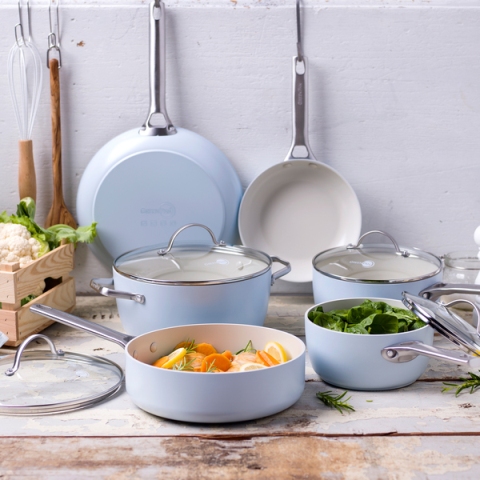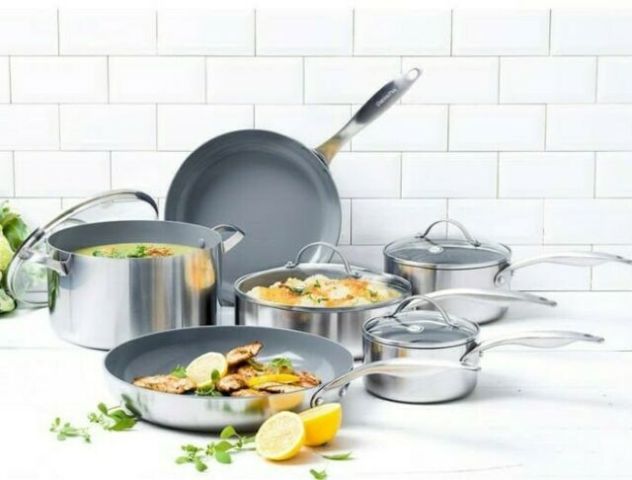Non-stick technology is fast gaining popularity across the globe. In almost every kitchen, there’s a need to have a non-stick pan for a better cooking experience. We all love non-stick cookware because even with little butter or oil, food doesn’t get to stick on the pan.
The market understands the need, that’s why we have brands like GreenPan to choose from. If you’re planning to get a set for your kitchen, you might consider reading through green pan reviews to find out if it’s the right one for you.
Before you purchase your cookware set, you may want to know whether it’s safe or not. With non-stick cookware, safety has been a major concern as some use toxic non-stick coatings. For a more thorough list of pros vs cons of green pan cookware, as well a list of the best green pan cookware sets, you can also check this article by HomeDesignX.
So, is GreenPan cookware safe or not?
Let’s break it down below.
What’s The Non-Stick Coating Used on GreenPan?

Unlike most non-stick cookware, GreenPan doesn’t have the Teflon coating common with most cookware. Teflon, otherwise known as PTFE, is the substance that makes most non-stick cookware unsafe. While PTFE hasn’t been established to cause cancer, the PFOA used to make it is considered a carcinogen, and pose serious health risks when it gets into the body.
When exposed to cooking heat, PTFE releases toxic fumes that sip into the food. Research findings indicate that PFOA can stay in your bloodstream for some time. This could lead to cancer, reduced fertility, and thyroid complications. Most brands market their pans products as PFOA-free, but you can’t assume their products are safe.
GreenPan is usually considered a safe alternative to Teflon non-stick cookware. GreenPan uses a ceramic non-stick coating that doesn’t contain PTFE. GreenPan uses a different technology under the name of Thermolon.
So, what’s Thermolon made of?
According to GreenPan, The ceramic coating used on its pans is made through a Sol-Gel process that forms a coating layer on the surface of the pans. The layer is mainly made up of Silicon Dioxide, that’s the same composition as glass.
Is Ceramic Coating Safe?
Now that you know GreenPan uses non-stick ceramic coating for its pans, you may want to know whether the coating is safe or not. Well, the ceramic coating is the alternative to Teflon, which is considered toxic. Therefore, that tells you it’s much safer than Teflon coating. Since ceramic coating doesn’t contain PFOA or PTFE, it’s considered 100% safe.
Additionally, the ceramic coating doesn’t contain any traces of toxic substances, and, therefore, doesn’t pose any health risk. It’s also environment-friendly.
High-Heat Cooking
Cooking over high heat is one way of preparing delicious meals. Even so, not every cookware can cook well over high heat. That’s why you need to be a bit selective when choosing your cookware. If you’re planning to buy GreenPan non-stick cookware, you may want to know if it’s good for high-heat cooking.
High-heat cooking requires strong materials, and most coatings used on non-stick cookware aren’t strong enough for this. While ceramic non-stick surfaces are great, they’re not safe when exposed to high heat.
The ceramic coating is easily damaged when exposed to high heat. Even so, it doesn’t contain any chemical substance.
The Thermolon coating used on GreenPan is heat resistant up to temperatures of about 450°C/850°F. The good thing is that the coating doesn’t release toxic fumes, and neither does it blister or peel.
Non-Stick Surfaces and High Heat Cooking

If you’re planning to cook on high heat, you better keep your non-stick pans away. At high temperatures, the non-stick coating used most cooking surfaces can melt or break down. As a result, toxic substances can be released into the food, which poses serious health risks. As we mentioned earlier, Teflon substances contain PFOA which is carcinogenic.
If you’re considering high heat cooking, you may have to look for other alternatives. In this case, you may consider other options such as stainless steel. While stainless still doesn’t cook the same way as non-stick cookware, they can survive high heat.
Benefits of Ceramic Cookware
There are several reasons why you should buy ceramic coated cookware like GreenPan. If you don’t have one, you may be encouraged to get a set after reading through these benefits.
Environment Friendly – Ceramic cookware doesn’t contain chemical substances such as PTFE that are made of fossil fuels that pollute the environment.
Durable – Ceramic coating is scratch-resistant and doesn’t wear easily. If you’re looking for non-stick pans that will last longer, consider brands like GreenPan which uses ceramic non-stick coating.
Energy-Efficient – Pans with ceramic coating heat up quickly, and so, you don’t need a lot of energy to get the pan hot. The good thing is that they also retain the heat very well, and, therefore, you don’t need to cook at high heat. Stainless steel can also do better, but you’ll like ceramic coating.
Easy To Clean – Ceramic coated pans and pots are the easiest to clean. You don’t need some special skills to get your pan sparkling clean. With its non-stick properties, food doesn’t stick on the pans. As such, you only need soap and warm water to clean the pans. While the ceramic coating is scratch-resistant, don’t use abrasive substances on it. The coating can peel off after some time.
So, Is GreenPan Safe Or Toxic?
We need to answer this to clear your doubts. Since GreenPan uses ceramic non-stick coating for its pans, it’s perfectly safe for you. No PTFE, no PFOA, and so, it’s safe for you. Just check what’s available in the market.
Final Thought
Non-stick cookware is a great asset in every kitchen. However, with coatings like Teflon that contain harmful chemicals, you have to look for safer alternatives. The good thing is that we have ceramic non-stick cookware like GreenPan.






